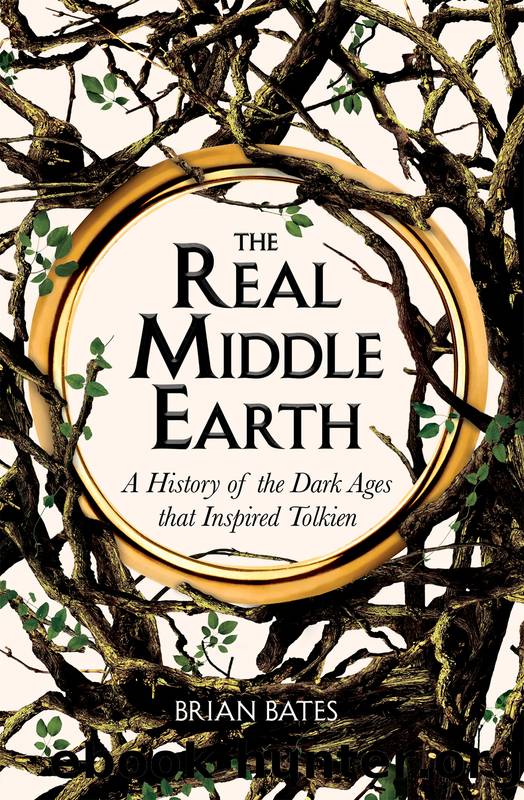The Real Middle-Earth by Brian Bates

Author:Brian Bates [Bates, Brian]
Language: eng
Format: epub
Publisher: Pan Macmillan
Published: 2022-06-14T17:00:00+00:00
Edwin was faced with a singing crow, but no longer had a wizard to interpret the message, and advise him how to profit from the birdâs warning. The bishop was galvanized into action by the petrified faces of Edwin and his entourage. It was imperative that he regain control of the situation. âShoot an arrow carefully into the birdâ he ordered. One of the kingâs bodyguards cocked his bow and fired. The arrow pierced the crow and it fell dead from the tree. Grasping the arrow, the bishop took the dead bird to the church hall, and there brandished it in the air in front of a probably sceptical congregation who had been ordered to show up for Christian instruction. Paulinus proclaimed that this âproved that they should know by so clear a sign that the ancient evil of idolatry was worthless to anybodyâ, since the bird âdid not know that it sang of death for itselfâ and so could not prophesy anything for those âbaptized in the image of Godâ. In other words, a bird which could not even foretell its own imminent death could not prophesy anything at all. Clearly Paulinus knew that the congregation would believe that a crow or raven had the gift of foretelling the future â it was one of the cursed âidolatriesâ which he was trying to stamp out.
Of course, this is a Christian story, presumbly slanted by its monkish author to show the wonders of that faith, and illustrate how misguided the pagan beliefs were. But Middle-earth wizards would have reckoned the bishop to have made a serious mistake. He had assumed that if the crow had known it was going to be shot, it would have tried to save its life by flying away. But prophetic animals were not merely mortal creatures. This crow was a âspirit messengerâ. It would not, in Middle-earth belief, have been afraid of âdeathâ in the material world. So the intervention of the bishop probably did not convince the congregation. And certainly the crowâs message was not interpreted for King Edwin.
Edwin perhaps took extra precautions, especially since he had already survived one assassination attempt. We do not know how long he survived after the crow incident, because we do not have a date for it. But when the end came, it was devastating. Edwin had been concentrating on the threats to his kingdom from various princely pretenders to the throne around whom ambitious warlords in the North were gathering. But instead, the fateful conclusion came from an alliance of the Mercian king Penda and the Welsh king Cadwallon. Penda was still a powerful and feared heathen warrior, brother of Edwinâs first, pagan wife. They killed Edwin in battle in 633 in the fenlands at Hatfield, near Doncaster. Queen Aethelburgh fled back to Kent with her children, accompanied by Bishop Paulinus. The kingdom of Northumbria was ravaged and burned by the invaders.
Yeavering Castle was apparently abandoned after Edwinâs death. Another site was established a short distance away at Millfield, where a new hall was built.
Download
This site does not store any files on its server. We only index and link to content provided by other sites. Please contact the content providers to delete copyright contents if any and email us, we'll remove relevant links or contents immediately.
| Africa | Americas |
| Arctic & Antarctica | Asia |
| Australia & Oceania | Europe |
| Middle East | Russia |
| United States | World |
| Ancient Civilizations | Military |
| Historical Study & Educational Resources |
Never by Ken Follett(2878)
The Man Who Died Twice by Richard Osman(2293)
Machine Learning at Scale with H2O by Gregory Keys | David Whiting(2281)
Fairy Tale by Stephen King(2062)
Will by Will Smith(2039)
Rationality by Steven Pinker(1763)
The Dawn of Everything: A New History of Humanity by David Graeber & David Wengrow(1570)
The Dark Hours by Michael Connelly(1565)
Principles for Dealing With the Changing World Order: Why Nations Succeed and Fail by Ray Dalio(1373)
Friends, Lovers, and the Big Terrible Thing by Matthew Perry(1326)
A Short History of War by Jeremy Black(1298)
HBR's 10 Must Reads 2022 by Harvard Business Review(1253)
Go Tell the Bees That I Am Gone by Diana Gabaldon(1233)
Can't Hurt Me: Master Your Mind and Defy the Odds - Clean Edition by David Goggins(1226)
515945210 by Unknown(1206)
Fear No Evil by James Patterson(1107)
443319537 by Unknown(1071)
Works by Richard Wright(1018)
Going There by Katie Couric(991)
